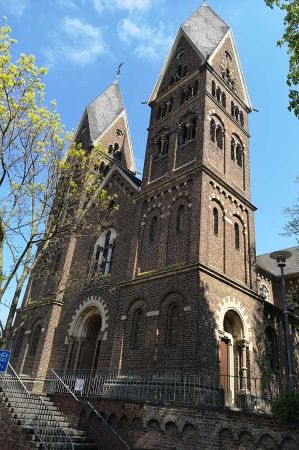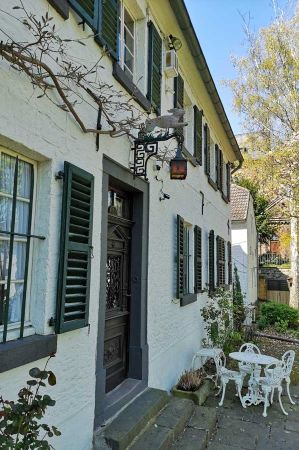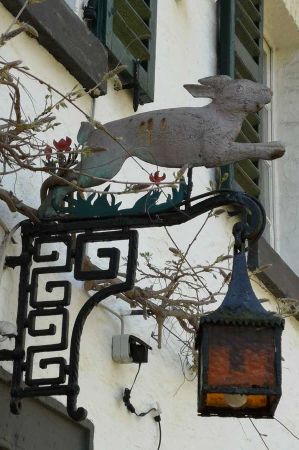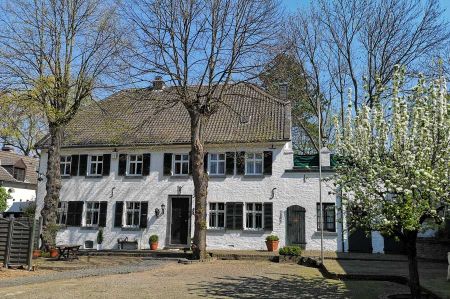Meeting at the Vitalis Church of Cologne - visit to the churchyard
- Written by Portal Editor
A meeting with Andreas should happen in Cologne, which was supposed to serve "just" the testing of the touring bike HNF XD2, this is followed in an article shortly, quickly expanded to a visit of an old churchyard next to Vitalis Church, which we had agreed as a meeting point.
As a distinctive point in the cityscape of Cologne easy to find, we wanted to test the touring bikes in city and off-road operation from here, without too much strain the character of the bike. And as often, there were complementary perspectives that were neither planned nor expected.
St. Vitalis Church in the old Müngersdorf
 Around the middle of the 19th century, the village Müngersdorf had about 260 inhabitants, but the church Vitalis was already built for 1200 people. The question of whether such a large church was justified in view of these numbers of inhabitants must still be left with answer. The answer may be found sometime later in the archives. Or the builders and planners were so much forward-looking that they already suspected later incorporation into the city of Cologne?
Around the middle of the 19th century, the village Müngersdorf had about 260 inhabitants, but the church Vitalis was already built for 1200 people. The question of whether such a large church was justified in view of these numbers of inhabitants must still be left with answer. The answer may be found sometime later in the archives. Or the builders and planners were so much forward-looking that they already suspected later incorporation into the city of Cologne?
In 1888 Müngersdorf was the date of incorporation into Cologne. Thus, the site got access to the infrastructure of the big city, for example to the water supply, sewage disposal, electricity and gas supply. Now the number of inhabitants grew rapidly. Now the size of the church fits.
The architect was Theodor Kremer, who at the turn of the century designed around 30 Neo-Romanesque and Neo-Gothic churches - a lucrative business. Master of construction was the Müngersdorfer Gerhard Denhoven, who built the houses 20 and 22 in the Belvedere street too. Anyone who knows Cologne will come up with the idea that he had already seen something similar. And correct. Anyone approaching from Neumarkt St. Aposteln immediately recognizes the similarity of St. Vitalis.
Former Kirchenhof - today used multifunctional
 Anyone being and feeling as a real inhabitant of Cologne will know the historical context of Müngersdorf and as a local historian might know that the abbey of St. Aposteln possessed large estates outside the gates of Cologne, as well as in Müngersdorf. The churchyard next to the church was one part of it, on the site of which the former church once stood. We were amazed when Andreas led us into the courtyard and garden of the large farm yard, we had not expected at this point. A large front yard, the immense large manor house with completely rebuilt courtyard by former stables and outbuildings today serves as a restaurant and is also is used for residential purposes. The legend says, that Napoleon should once have spent the night here in the manor, whether in the context of his first successful conquest or during his retreat on the run from the troops of Prussia, remains open.
Anyone being and feeling as a real inhabitant of Cologne will know the historical context of Müngersdorf and as a local historian might know that the abbey of St. Aposteln possessed large estates outside the gates of Cologne, as well as in Müngersdorf. The churchyard next to the church was one part of it, on the site of which the former church once stood. We were amazed when Andreas led us into the courtyard and garden of the large farm yard, we had not expected at this point. A large front yard, the immense large manor house with completely rebuilt courtyard by former stables and outbuildings today serves as a restaurant and is also is used for residential purposes. The legend says, that Napoleon should once have spent the night here in the manor, whether in the context of his first successful conquest or during his retreat on the run from the troops of Prussia, remains open.
Napoleon Bonaparte in Müngersdorf
After Napoleon Bonaparte was proclaimed French Emperor on 18 May 1804, he made a trip to the French departments of the Rhineland in the late summer of the year. The city of Cologne also belonged to France since 1794, in September 1804 the emperor visited the cathedral city. The Mayor of Cologne, Johann Jakob von Wittgenstein, was informed about the upcoming visit just two weeks before. With great effort, the city was prepared for the visit of the emperor. In particular, the city administration and the management wanted to give a good impression and counteract the bad reputation of the Rhinelanders. Thus, streets and public spaces were cleaned, the citizens of the city called for moderate behavior, the hotel, Blankenheimer yard 'on Neumarkt furnished as an imperial residence and decorated the public buildings of the city elaborately.
 On September 13, 1804, Napoleon finally arrived in Cologne and was received in front of the Eigelsteintor in the north of the city by von Wittgenstein and other municipal officials. With the sound of bells and gunfire Napoleon and his wife Joséphine de Beauharnais, followed by a large entourage moved into the city and passed a purpose-built triumphal arch and a guard of honor from 38 distinguished Cologne citizens.
On September 13, 1804, Napoleon finally arrived in Cologne and was received in front of the Eigelsteintor in the north of the city by von Wittgenstein and other municipal officials. With the sound of bells and gunfire Napoleon and his wife Joséphine de Beauharnais, followed by a large entourage moved into the city and passed a purpose-built triumphal arch and a guard of honor from 38 distinguished Cologne citizens.
During his stay in Cologne, Napoleon was interested in the sights of the city. As a kind of rule for explaining the city, Ferdinand Franz Wallraf was responsible for guiding famous guests through the city, so that he also showed the cathedral city to the imperial couple. In a later letter from Wallraf to the Empress Joséphine, he referred explicitly to her visit to Cologne and his tour of the city. Napoleon, however, seemed to be particularly interested in the Cologne trade and visited, among other things, the port. On September 17, 1804, the imperial couple left the city and traveled on to Bonn. The visit seems to have been a success for all sides: Napoleon announced his farewell "Cologne, contentement", Maire von Wittgenstein listed the pardons of Napoleon for Cologne shortly after.
Please read as well:
With the Ruhrtal ferry boat to the castle ruins Hardenstein
Kettwig - rural, idyllic gem on the Ruhr river
-
 ST. Vitalis Church und Church Farm in Müngersdorf
ST. Vitalis Church und Church Farm in Müngersdorf
ST. Vitalis Church und Church Farm in Müngersdorf
ST. Vitalis Church und Church Farm in Müngersdorf
-
 ST. Vitalis Church und Church Farm in Müngersdorf
ST. Vitalis Church und Church Farm in Müngersdorf
ST. Vitalis Church und Church Farm in Müngersdorf
ST. Vitalis Church und Church Farm in Müngersdorf
-
 ST. Vitalis Church und Church Farm in Müngersdorf
ST. Vitalis Church und Church Farm in Müngersdorf
ST. Vitalis Church und Church Farm in Müngersdorf
ST. Vitalis Church und Church Farm in Müngersdorf
-
 ST. Vitalis Church und Church Farm in Müngersdorf
ST. Vitalis Church und Church Farm in Müngersdorf
ST. Vitalis Church und Church Farm in Müngersdorf
ST. Vitalis Church und Church Farm in Müngersdorf
-
 ST. Vitalis Church und Church Farm in Müngersdorf
ST. Vitalis Church und Church Farm in Müngersdorf
ST. Vitalis Church und Church Farm in Müngersdorf
ST. Vitalis Church und Church Farm in Müngersdorf
-
 ST. Vitalis Church und Church Farm in Müngersdorf
ST. Vitalis Church und Church Farm in Müngersdorf
ST. Vitalis Church und Church Farm in Müngersdorf
ST. Vitalis Church und Church Farm in Müngersdorf
-
 ST. Vitalis Church und Church Farm in Müngersdorf
ST. Vitalis Church und Church Farm in Müngersdorf
ST. Vitalis Church und Church Farm in Müngersdorf
ST. Vitalis Church und Church Farm in Müngersdorf
-
 ST. Vitalis Church und Church Farm in Müngersdorf
ST. Vitalis Church und Church Farm in Müngersdorf
ST. Vitalis Church und Church Farm in Müngersdorf
ST. Vitalis Church und Church Farm in Müngersdorf
-
 ST. Vitalis Church und Church Farm in Müngersdorf
ST. Vitalis Church und Church Farm in Müngersdorf
ST. Vitalis Church und Church Farm in Müngersdorf
ST. Vitalis Church und Church Farm in Müngersdorf
-
 ST. Vitalis Church und Church Farm in Müngersdorf
ST. Vitalis Church und Church Farm in Müngersdorf
ST. Vitalis Church und Church Farm in Müngersdorf
ST. Vitalis Church und Church Farm in Müngersdorf
-
 ST. Vitalis Church und Church Farm in Müngersdorf
ST. Vitalis Church und Church Farm in Müngersdorf
ST. Vitalis Church und Church Farm in Müngersdorf
ST. Vitalis Church und Church Farm in Müngersdorf
-
 ST. Vitalis Church und Church Farm in Müngersdorf
ST. Vitalis Church und Church Farm in Müngersdorf
ST. Vitalis Church und Church Farm in Müngersdorf
ST. Vitalis Church und Church Farm in Müngersdorf
https://www.alaturka.info/en/germany/north-rhine-westphalia/4803-meeting-at-the-vitalis-church-of-cologne-visit-to-the-churchyard#sigProIdd0b3e912f8

